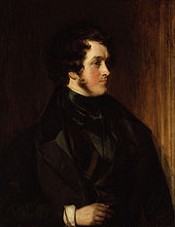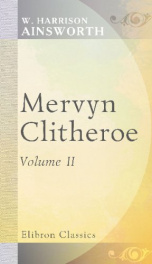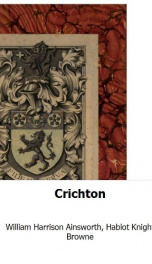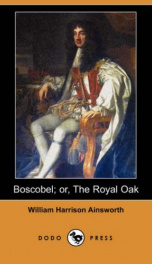William Harrison Ainsworth (4 February 1805 – 3 January 1882) was an English historical novelist born in Manchester. He trained as a lawyer, but the legal profession held no attraction for him. While completing his legal studies in London he met the publisher John Ebers, at that time manager of the King's Theatre, Haymarket. Ebers introduced Ainsworth to literary and dramatic circles, and to his daughter, who became Ainsworth's wife. Ainsworth briefly tried the publishing business, but soon gave it up and devoted himself to journalism and literature. His first success as a writer came with Rookwood in 1834, which features Dick Turpin as its leading character. A stream of 39 novels followed, the last appearing in 1881. Ainsworth died in Reigate on 3 January 1882. Ainsworth was born on 4 February 1805 to Thomas Ainsworth, a prominent Manchester lawyer, and Ann (Harrison) Ainsworth in the family house at 21 King Street, Manchester. On 4 October 1806, Ainsworth's brother, Thomas Gilbert Ainsworth, was born. Although the family home was eventually destroyed, it was a three-storey Georgian home in a well to do with community. The area influenced Ainsworth with its historical and romantic atmosphere, which existed until the community was later replaced by commercial buildings. Besides the community, Ainsworth read romantic works as a child and enjoyed stories dealing with either adventure or supernatural themes. Of these, Dick Turpin was a favourite of Ainsworth. During his childhood, he adopted Jacobean ideas and held Tory ideas in addition to his Jacobite sympathies, even though his community was strict Whig and Nonconformist. During this time, Ainsworth began to write prolifically.[2] The Ainsworth family moved to Smedly Lane, north of Manchester in Cheetham Hill, during 1811. They kept the old residence in addition to the new, but resided in the new home most of the time. The surrounding hilly country was covered in woods, which allowed Ainsworth and his brother to act out various stories. When not playing, Ainsworth was tutored by his uncle, William Harrison. In March 1817, he was enrolled at the Manchester Grammar School, which was described in his novel Mervyn Clitheroe. The work emphasized that his classical education was of good quality but was reinforced with strict discipline and corporal punishment. Ainsworth was a strong student and was popular among his fellow students. Ainsworth's school days were mixed; his time within the school and with his family was calm even though there were struggles within the Manchester community, the Peterloo Massacre taking place in 1819. Ainsworth was connected to the event because his uncles joined in protest at the incident, but Ainsworth was able to avoid most of the political after-effects. During the time, he was able to pursue his own literary interests and even created his own little theatre within the family home at King Street. He, along with his friends and brother, created and acted in many plays throughout 1820.[3] During 1820, Ainsworth began to publish many of his works under the name "Thomas Hall". The first work, a play called The Rivals, was published on 5 March 1821 in Arliss's Pocket Magazine. Throughout 1821, the magazine printed 17 other works of Ainsworth's under the name "Thomas Hall", "H A" or "W A". The genre and forms of the work greatly varied, with one being a claim to have found plays of a 17th-century playwright "William Aynesworthe", which ended up being his own works. This trick was later exposed. In December 1821, Ainsworth submitted his play Venice, or the Fall of the Foscaris to The Edinburgh Magazine. They printed large excerpts from the play before praising Ainsworth as a playwright as someone that rivalled even George Gordon Byron. During this time, Ainsworth was also contributing works to The European Magazine in addition to the other magazines, and they published many of his early stories. Eventually, he left the Manchester Grammar School in 1822 while constantly contributing to magazines.[4] After leaving school, Ainsworth began to study for law and worked under Alexander Kay. The two did not get along, and Ainsworth was accused of being lazy. Although Ainsworth did not want to pursue a legal career, his father pushed him into the field. Instead of working, Ainsworth spent his time reading literature at his home and various libraries, including the Chetham Library. He continued to work as an attorney in Manchester and spent his time when not working or reading at the John Shaw's Club. By the end of 1822, Ainsworth was writing for The London Magazine, which allowed him to become close to Charles Lamb, to whom Ainsworth sent poetry for Lamb's response. After receiving a favourable response for one set of works, Ainsworth had them published by John Arliss as Poems by Cheviot Ticheburn. He travelled some during 1822, and visited his childhood friend James Crossley in Edinburgh during August. While there, Crossley introduced Ainsworth to William Blackwood, the owner of Blackwood's Magazine, and, through Blackwood, was introduced to many Scottish writers.[5] Besides Crossley, another close friend to Ainsworth was John Aston, a clerk that worked in his father's legal firm. In 1823, Ainsworth and Crossley started to write many works together, including the first novel Sir John Chiverton. Ainsworth wrote to Thomas Campbell, editor of The New Monthly Magazine, about publishing the work but Campbell lost the letter. After being asked by Ainsworth, Crossley travelled to London to meet Campbell and discuss the matter before visiting in November. Although the novel was not yet published, in December 1823, Ainsworth was able to get G. and W. Whittaker to publish a collection of his stories as December Tales. During 1824, Ainsworth set about starting his own magazine, which became The Boeotian and was first published on 20 March. However, the magazine ended after its sixth issue on 24 April.[6] Ainsworth's father died on 20 June 1824. As such, Ainsworth became a senior partner in the law firm and started to focus on his legal studies. To this end he left for London at the end of 1824 to study under Jacob Phillips, a barrister at King's Bench Walk. Ainsworth lived at Devereux Court, a place that was favoured by Augustine writers. During his stay, Ainsworth visited Lamb, but he felt let down by the real Lamb. Ainsworth attended Lamb's circle, and met many individuals including Henry Crabb Robinson and Mary Shelley. During the summer of 1825, Ainsworth returned on a trip to Manchester in order to meet Crossley before travelling to the Isle of Man. He continued to write, and a collection of his poems called The Works of Cheviot Tichburn, with the types of John Leigh was published. He also had two works published in The Literary Souvenir,[7] a magazine published by John Ebers.[8] On 4 February 1826, Ainsworth came of age. Soon afterwards, on 8 February, he was made a solicitor of the Court of King's Bench. During this time, he befriended Ebers, who also owned the Opera House, Haymarket. Ainsworth would constantly visit shows at the house, and he fell in love with Ebers's daughter Fanny during his visits. The relationship with the Ebers family continued, and John published a pamphlet of Ainsworth's called Considerations on the best means of affording Immediate Relief to the Operative Classes in the Manufacturing Districts. The work, addressed to Robert Peel, discussed the economic situation in Manchester along with the rest of Britain. By June, Ainsworth left politics and focused on poetry with the publication of Letters from Cokney Lands. While these were printed, Ainsworth continued to work on his novel Sir John Chiverton and sought to have it published.[9] The novel was published by Ebers in July 1826.[10] Ebers became interested in Ainsworth's novel early on and started to add discussions about it in the The Literary Souvenir in order to promote the work. Although the work was jointly written and sometimes claimed by Aston as solely his, many of the reviews described the novel as Ainsworth's alone. The novel also brought Ainsworth to the attention of historical novelist Walter Scott, who later wrote about the work in various articles; the two later met in 1828. During that year, J. G. Lockhartt published Scott's private journals and instigated the notion that the novel was an imitation of Scott. Sir John Chiverton is neither a true historical novel nor is it a gothic novel. It was also seen by Ainsworth as an incomplete work and he later ignored the work when creating his bibliography. The novel does serve as a precursor to Ainsworth's first major novel, Rookwood.[11] Ainsworth's relationship with the Ebers family grew, and he married Fanny on 11 October 1826 with little warning to his family or friends. Ebers promised to pay a dowry of 300 pounds, but the funds were never given and this caused a strain in the relationship between Ainsworth and his father-in-law. Ainsworth continued in Ebers's circle and attended many social events. He was encouraged by Ebers to sell his partnership in the Ainsworth law firm along with starting a publishing business. Ainsworth followed this advice, and the business had early success. In 1827, Fanny gave birth to a girl who took her name. Soon after, Ebers went bankrupt and Ainsworth loss a large sum in return. Ainsworth published a few popular works, including The French Cook, the annual magazine Mayfair, and some others. By 1829, Ebers took over Ainsworth's publishing business, and Fanny gave birth to another daughter, Emily, soon after. Ainsworth gave up on publishing and resumed working in law. When a third daughter, Anne, was born in 1830, Ainsworth's family began to feel financially strained. Ainsworth returned to writing and he contributed to Fraser's Magazine, but it is uncertain how many works were actually his. However, he was working on his novel Rookwood.[12] Starting in 1829, Ainsworth was neither a lawyer nor a publisher; indeed he didn't have any employment at all. He longed for his youthful days in Manchester and pondered writing another novel. By the summer, he began to travel.[13] It was during this time that Ainsworth began to develop the idea of Rookwood, and he began searching for information dealing with the subject.[14] While researching for the novel in 1830, Ainsworth was living at Kensal Lodge. He worked on some theatrical pieces and spent the rest of his time working in the legal profession. He soon became friends with William Sergison, and the two travelled to Italy and Switzerland during that summer. During their travels, they visited the tomb of Percy Bysshe Shelley and John Keats, along with witnessing other notable scenes in the lives of the British Romantic poets. Sergison was also the owner of a residence in Sussex, upon which Ainsworth drew in his novel. After the two returned to London, Ainsworth began working for Fraser's Magazine, which was launched in 1830. The group included many famous literary figures of the day, including Samuel Taylor Coleridge, Robert Southey, Thomas Carlyle, James Hogg and William Makepeace Thackeray.[15] It was not until a visit to Chesterfield, during Autumn 1831, that he was fully inspired to begin writing the novel.[16]










